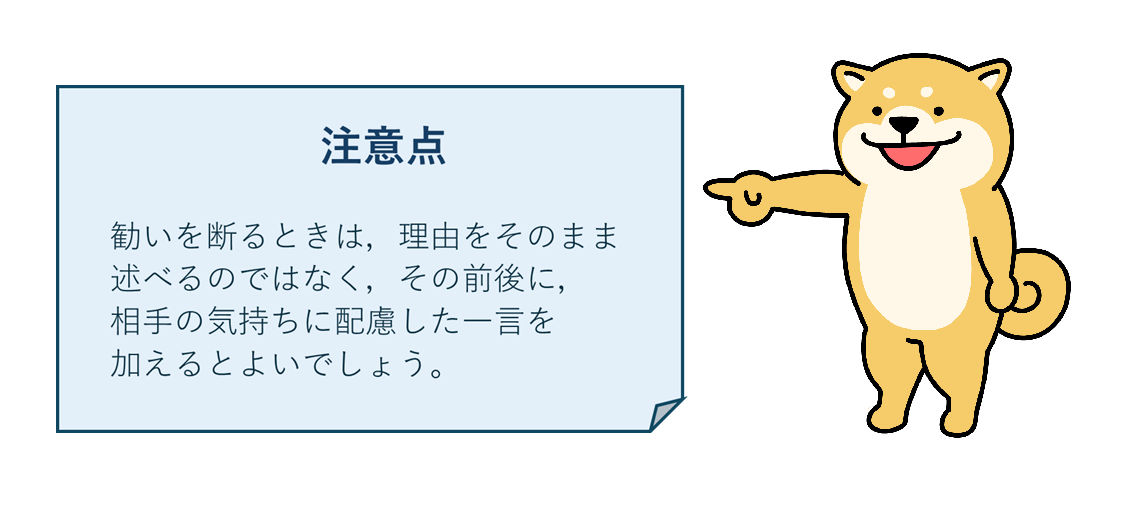���Ƃ̃����|�C���g
�U����f��
����ޓ�����Listening ����Step 1�ip.98�j
�@�����ł́C�U�������Ƃ��ɁC����̋C�����ɔz�����Ēf�邱�Ƃ��ł��邱�Ƃ�ڕW�Ƃ��Ă��܂��B
�i1�j�{���̖ڕW��������܂��B
�y���b��z
T�F Today, we will learn how to decline, or say no respectfully and in a friendly manner to someone when they ask us to join them.
�i2�j���t�� ALT ���U����f��������f�����X�g���[�V�������܂��B���k�͕{��ԂŁC�f�����X�g���[�V���������܂��B
�y��b��z
T�F First, please listen to our demo conversation.
ALT�F Yeah! I've got three tickets for a musical from my father.
�@�@One is for Ryo, and the other is....
�@�@Oh, I think I should invite Erika! She told me the other day that she liked musicals!
�i�����܂ŃA�h���u�B�ȍ~�́C���ȏ�p.98 �̃��f����b��ǂݏグ�܂��B�j
ALT�F Hi, Erika! There will be a new musical at the theater next Saturday and I'm planning to go there with Ryo.
�@�@Why don't you join us?
�i�����\�����Ȃ���b���B�j
T�F I'd like to, but I have another appointment on that day.
ALT�F Oh, I see.
T�F Thank you for asking me!
�@�@I hope to go with you next time.
�i�ȍ~���A�h���u�B�j
ALT�F OK. I'll tell you if I get some tickets from my father again.
T�F So kind of you!
�EALT �����Ȃ��ꍇ�́C�f�����X�g���[�V���������C���X�j���O�̂ݍs���Ă��悢�ł��傤�B
�y���b��z
T�F Now, let's listen to the dialogue first.
�i3�j�����̓��e�ɂ��� Q&A ���s���܂��B
�E�����ŐV�o���� �gappointment�h �ɂ��Ĕ����ƈӖ����m�F����Ƃ悢�ł��傤�B
�y��b��z
T�F Now, class, please answer my questions.
�@�@Question 1. What did Sam want Erika to do?
S1�F (Join Sam and Ryo to) go to see a musical.
T�F Good. Question 2.
�@�@Can Erika join?
S2�F No.
T�F All right. Question 3.
�@�@Why can't Erika join them?
S3�F She has another appointment.
T�F Exactly. What does appointment mean?
S4�F �H
T�F That's right.
�@�@Appointment means ��.
�@�@Repeat after me. �gAppointment.�h
S�F Appointment.
T�F Good. Then, question 4.
�@�@Do you think Erika wanted to join them?
S5�F Yes.
T�F Why did you think so?
�@�@What did Erika say?
S6�F She said, �gI'd like to.�h
S7�F She said, �gThank you.�h
T�F Exactly. She also told Sam that she hoped to go with him next time.
�@�@Now, let's review some key phrases in the dialogue.
�@�@Please repeat, �gI'd like to, but ....�h
�@�@�gI hope to go with you next time.�h
�i���t�̂��Ƃɑ����āC1�����ǂ���B�j

��Key Expressions �̉��p.98
�i��j
�@ I'd like to, but I have another appointment on that day.
�@�i�����������̂ł����C���̓��͕ʂ̖�����܂��B�j
�A I hope to go with you next time.
�@�i���Ȃ��ƈꏏ�ɍs���邱�Ƃ�]��ł��܂��B�j
�k�`���l
�E�@�́CI'd like to, but �` �Łu�����������̂ł����C�`�v�Ƃ����Ӗ��B���U��f��Ƃ��̕\���̈�ł��Bbut �̌�ɂ͒f�闝�R���������𑱂��܂��B
�E�A�́qI hope to �{�����̌��`�r�ŁC�u�`�������C�ł���Ƃ����ˁv�Ƃ����Ӗ��B�����ł́C�U���Ă��ꂽ����̋C�����ɔz������\���ƂȂ��Ă��܂��B
�k�@�\�ƈӖ��l
�E�U����f��Ƃ��ɁC�܂��́u����������v�Ƃ����ӎv�������������ŁC�u�f�闝�R�v�ɉ����āu�f�邱�Ƃɑ���c�O�ȋC�����v��\�����܂��B

��Writing & Speaking ����Step 3�ip.98�j
�i1�j���[�N�V�[�g��z�z���C�y�A�ŃX�L�b�g���쐬���܂��B
�E���[�N�V�[�g�͎��Ԑߖł���I�����Ǝ��R�L�q���̂Q�ʂ肠��܂��B���k�̏ɍ��킹�đI�т܂��傤�B
�E���k���X�L�b�g���쐬���́C���t�͊��ԏ������Đ��k���T�|�[�g���܂��B
�i2�j�����ł̃X�s�[�L���O�ɒ��킵�܂��B
�E�N���X���Ŏ��R�Ƀy�A������Ęb���܂��B���[�N�V�[�g�����p���āC�������U������C����̗U��������������f�����肷����������܂��傤�B
�y���b��z
T�F Now, let's try impromptu interactions.
�@�@Look at the chart on your worksheet.
�@�@There are things to enjoy.
�@�@Choose one event to which you will say �gyes�h if you are invited and mark the checkbox.
�@�@Do not show it to anyone.
�@�@For example, I want to see a new movie at the theater.
�@�@Which checkbox do I need to mark?
S�F Three.
T�F Right. How about you?
�@�@Please mark the checkbox now.
S�F OK.
T�F You will talk freely to your classmates and find someone to accept your invitation.
�@�@After asking your partner, switch roles and listen to your partner�fs invitation.
�@�@If it is not the event you decided to accept, you must decline nicely and politely.
�@�@For example, if someone tells me that there will be a classical music concert next Sunday, and asks to go with him or her, I will say, �gI wish I could, but I have to finish my homework.
�@�@Thank you for asking me!
�@�@I hope to go with you next time.�h You got it?
S�F Yes!
T�F Well, find a partner to talk to and start your conversation with �gHi!
�@�@There will be a ....�h
�@�@Everybody, please stand up and go ahead.
�i���Ԃ�������Ȃɖ߂点�C�����̐U��Ԃ�����[�N�V�[�g�ɋL������B�j
T�F Now, time is up.
�@�@Please stop.
�@�@Review today's lesson quickly.
�@�@What did you learn from today's lesson?

���⑫p.98
�E���t��\�����w�Ԃ����ł͂Ȃ��C�~���ȃR�~���j�P�[�V�����\�͂�g�ɂ��邱�Ƃ�O���ɒu���Ďw�����܂��傤�B
�ESNS��A�v���ł���������Ƃ����C���̂悤�ɑ���̋C�����ɔz�������\�����g���Ēf���悤�ɂ��������Ƃ�`���Ă��悢�ł��傤�B
�yLet's Talk 3�z
�U����f��
�i���ȏ�p.98�j
�A���P�[�g
��낵����L���ɂ��Ă̂��ӌ��������������������B
Q1�܂���Q3�̂����ꂩ����͂����͂��������B

